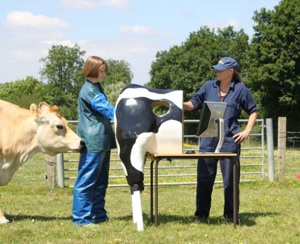A magazine where the digital world meets the real world.
On the web
- Home
- Browse by date
- Browse by topic
- Enter the maze
- Follow our blog
- Follow us on Twitter
- Resources for teachers
- Subscribe
In print
What is cs4fn?
- About us
- Contact us
- Partners
- Privacy and cookies
- Copyright and contributions
- Links to other fun sites
- Complete our questionnaire, give us feedback
Search:
Can you feel it?

How’s this for a scary experience: imagine you’re a new surgeon, about to perform your first operation. If you’re like most surgeons, your training up until now has mostly consisted of watching other surgeons work, and maybe being allowed to do one or two small things to help out. That’s it. Now you’re in the spotlight, and there’s a real person lying on the table in front of you. Hope your hands aren’t shaking much.
Very simulating
Fortunately, training simulators are starting to be used more and more to give medical students something to practise on. They’re finally getting cheap and powerful enough to allow more medical schools to buy them. Many modern simulators can even make it feel like you’re working on the real thing by giving you feedback through your sense of touch. That’s called ‘haptics’. The simulator gives back the same movement and resistance you might get if you were genuinely suctioning blood or drilling into bone.
One of the newest simulators, developed at Stanford University in California, goes one better. It doesn’t just have you practise on a made-up, model patient: you can actually upload real patient data into the simulator and practise for a real surgery you might be just about to do! The Stanford folks practise sinus surgery, so their simulator is a mannequin’s head attached to a haptics system. The surgeon’s job is to insert a small camera in a tube, called an endoscope, into the patient’s nose. Based on how far the scope goes down the sinus cavity, the haptics system figures out the amount of resistance the student should feel. It won’t be just for students though. Senior doctors might want to upload data from patients to practise what they think might be a particularly difficult surgery.
Delicate matters

Haptics can play a role in training not just doctors, but veterinarians – and it can help not just in the head but, er, at the other end too. Trainee vets have to learn how to feel for animals’ organs. In small animals like dogs and cats you can do that just by feeling the outside of their tummies, but in larger animals like cows or horses you have to actually put your hands inside them. That’s right, up there. Now the thing is, this is a very difficult thing to learn how to do properly. A teacher can’t demonstrate it, because the student can’t see what they’re doing. Likewise when the student tries it, the teacher can’t see to know if they’re doing it right. Usually they just rely on describing what they’re doing (and how the animal reacts, of course).
Fortunately for teacher, student and especially animal, Sarah Baillie and her colleagues at the Royal Veterinary College have invented a simulator called the Haptic Cow. It’s a haptic model of a cow’s rear end, complete with ‘Ouchometer’ – a graph that shows whether the student’s movements are too gentle to be effective, just right, or too rough to be safe. By using the Haptic Cow, students still get an accurate idea of what they’ll be doing in their real jobs, the teachers can see better feedback of how well the student’s doing, and real cows don’t have to worry about being used to practise on. For doctors, vets and their patients, haptics are helping to make sure that practice doesn’t have to mean petrifying.
Sources: Wired Science and The Royal Society Summer Science Exhibition. Haptic Cow image © copyright Royal Veterinary College.


